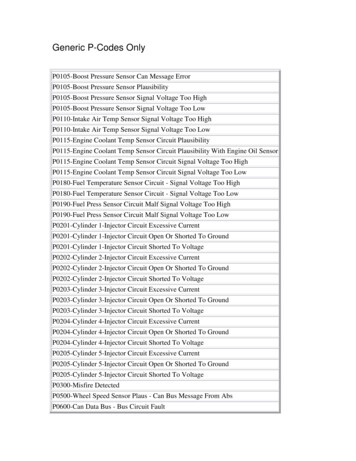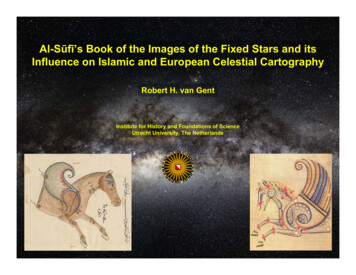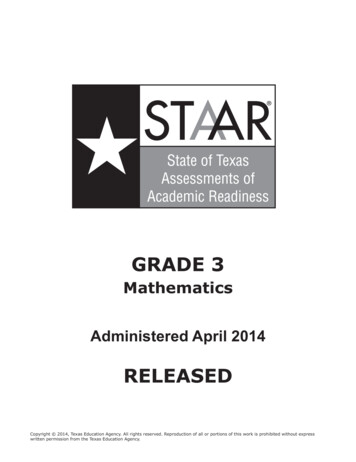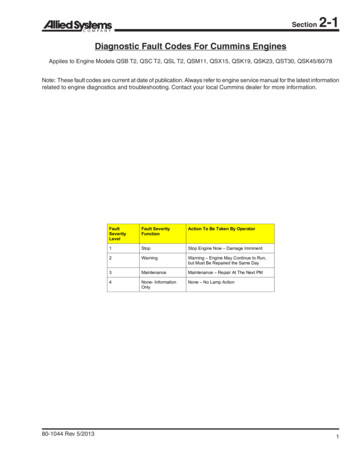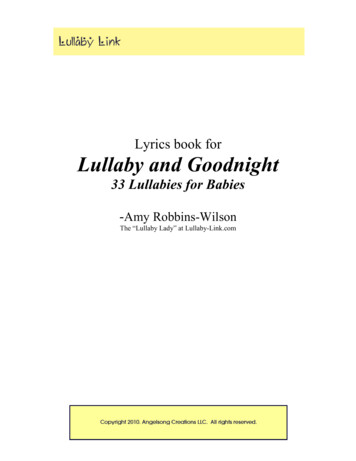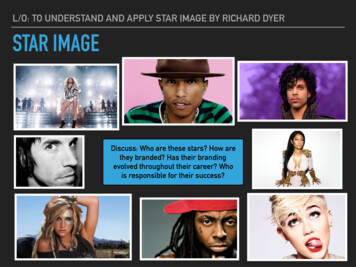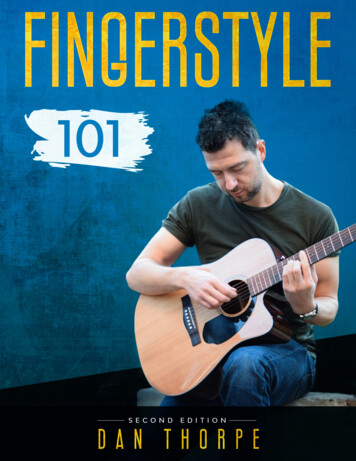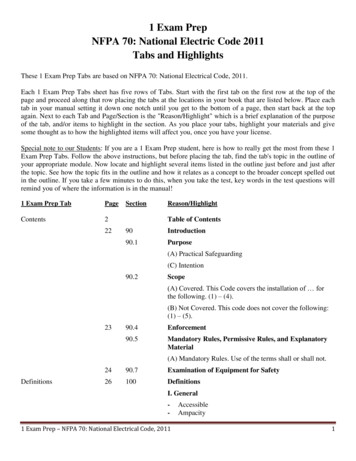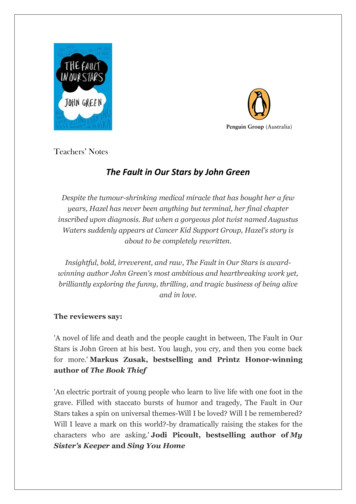
Transcription
Teachers’ NotesThe Fault in Our Stars by John GreenDespite the tumour-shrinking medical miracle that has bought her a fewyears, Hazel has never been anything but terminal, her final chapterinscribed upon diagnosis. But when a gorgeous plot twist named AugustusWaters suddenly appears at Cancer Kid Support Group, Hazel's story isabout to be completely rewritten.Insightful, bold, irreverent, and raw, The Fault in Our Stars is awardwinning author John Green's most ambitious and heartbreaking work yet,brilliantly exploring the funny, thrilling, and tragic business of being aliveand in love.The reviewers say:'A novel of life and death and the people caught in between, The Fault in OurStars is John Green at his best. You laugh, you cry, and then you come backfor more.' Markus Zusak, bestselling and Printz Honor-winningauthor of The Book Thief'An electric portrait of young people who learn to live life with one foot in thegrave. Filled with staccato bursts of humor and tragedy, The Fault in OurStars takes a spin on universal themes-Will I be loved? Will I be remembered?Will I leave a mark on this world?-by dramatically raising the stakes for thecharacters who are asking.' Jodi Picoult, bestselling author of MySister's Keeper and Sing You Home
'John Green writes incredible, honest truths about the secret, weird hearts ofhuman beings. He makes me laugh and gasp at the beauty of a sentence or thetwist of a tale. He is one of the best writers alive and I am seething with envyof his talent.' E. Lockhart, National Book Award Finalist and PrintzHonor-winning author of The Disreputable History of FrankieLandau Banks and The Boyfriend List
Teacher Review - Spoiler Alert: The Price of Dawn is Blood byRohan CliffordWhen you get your hands on a copy of John Green’s new book The Fault inOur Stars, check inside the cover. Green personally autographed the first 150000 copies (the entire first print run), at least that’s what Wikipedia has to sayon the matter (http://en.wikipedia.org/wiki/John Green (author)). SinceGreen’s 2005 acclaimed debut novel Looking for Alaska, and thesubsequent An Abundance of Katherines and Paper Towns, Green hascollaborated on 3 more books and released short stories for variouscompendiums, as well as a great deal of on-line and interactive material. This,despite having possibly the worst hand cramp in history. or possibly,Wikipedia is wrong. Which is possible, because not everything can be plainsailing in an infinite universe. You just have to take your chances. That’s thecredo of the characters in Green’s new novel, existing as they do in a universeseemingly oblivious to their suffering. A universe, which allows the young andpromising to die from horrible and dehumanising cancers, and leaving theliving scarred.Unlike many cancer stories, Green’s novel looks at the view from withincourtesy of a support group, meeting regularly in a church splayed out in theshape of a cross. This is where sixteen year old, parentally-adored andterminal (no spoiler) Hazel, meets survivor Augustus through mutual friendand fellow resident of Cancervania, Isaac. Amidst all the seeming fragility ofwhat becomes known as survivor’s group, there is a blunt acceptance of theabove-mentioned credo. The view from inside the universe of potentiallyterminal disease, as you would expect, is full of fear and desperation, but alsoacceptance and coping. From outside that world, we might call it bravery.Inside, you don’t have the choice of bravery, so it is just how you get on with it.Or how you don’t.There’s an edge to the voice of Green’s characters that is confronting. They’retough. They yell from the page like a short-changed New York Cabbie, eventhough the story is set in Indiana. And that’s even when they’re not yelling.The dialogue in The Fault in our Stars is at times cynical and quick-fire,hinting, perhaps at ways of coping with the obscene brutality of cancer.
I didn’t tell him that my diagnosis came just three months after Igot my first period. Like: Congratulations! You’re a woman. Nowdie.Hazel continues to exist, largely thanks to a range of hospital equipment andmedication, including a portable oxygen tank because, as she admits, herlungs suck at being lungs. All the while Hazel struggles to draw breath, shenourishes us readers with some impressive observations:There is only one thing in this world shi**ier than biting it fromcancer when you’re sixteen, and that’s having a kid who bites itfrom cancer.Observations, which reveal the world-view of a sensitive soul in a ghastly,insensitive universe. But it’s not all cannulas and treatment, gradualdismemberment and slow suffocation.On the outskirts of Cancervania, parents have their own survival methods,forcing themselves to cope with the daily terror of losing their onceblossoming children to the destruction of their own cells. Some manage byembracing positive affirmations, over time emblazoning them acrosscushions, placemats, bed spreads until entire households become museums ofabsurd positivity. (My parents call them encouragements, explainsAugustus).Some are stoic. Some are comically hopeless, crying at the mention of death,or at the mention of anything that might lead to the mention of death. Someare absent, others, very much, are present.In Green’s novel, there is love, and of course there is loss. There is much,much humour and teenage angst. There is diminution and there is growth, thereduction and destruction of beautiful human beings and their glorious,gorgeous evolution. There is the same constant search for meaning, unitingthe dying with the living, the blamed with the blameless. Underpinning all ofthis, there is the very human question of why or how this could happen.Answers are found in the writing of Hazel’s revered and reclusive Dutchauthor Peter Van Houten, who has written just one novel An ImperialAffliction, the closest thing Hazel has ever had to a bible (Pain demands to
be felt, says Van Houten). It is when she reluctantly shares her devotion tothis book with Augustus (who returns the favour by introducing Hazel to ThePrice of Dawn and it’s triple digit zombie-death count) that the sparks ofattraction are kindled. The ensuing romance, acknowledged by both parties asinherently star-crossed and quite possibly futile is funny, uplifting, perhapseven death-defying.He sighed, exhaling for so long that to my crap lungs it seemedlike he was bragging.Beautiful.The Fault in our Stars is not about dealing with cancer or about cancer per se.It is about how brilliantly well these smart and truly tangible characters reactand cope with what an infinite universe has dealt them and how we canidentify ourselves as the bumbling, well-meaning idiots who live somewhereoutside Cancervania.There is not meaning to be found in these stars. But there is meaning to bemade.
Key Understandings & skillsInformation and communication technology (ICT) competence:Research and critically evaluate information in relation to the text, onthe InternetDigital ScrapbookBook Trailer creationICT activities as listed belowCritical and Creative Thinking:Infer character motivationLocate and interpret evidenceReinforce the comprehension strategiesMake personal connections to the text and reflect on related issuesInvestigate author characterization and settingHow authors use imagery effectivelyCharacter profiles, character mapsProblem solvingEthical Behaviour/ Personal and Social Competence:Personal connections – how might you react to situations if you were inthis situation?Make personal connections to the text and reflect on related issuesRealism of the story – realism versus narrative. Could this situationreally happen?Use as a model for personal reflective writing based on experienceAssessment‘For’ assessment:Digital Scrapbook/Writers Notebook.This will lead students to reflect on and respond to The Fault in Our Stars,by creating a digital scrapbook/writers notebook. Students view a sampleelectronic scrapbook and use the project rubric to evaluate it, becomingfamiliar with the project requirements in the process. They use an online toolto evaluate resources on a topic related to a piece of literature and post theirevaluations for class reference. Students then use online resources to capture“scraps” of information about their assigned topic and create a scrapbookusing Keynote/PowerPoint, Prezi, iMovie/Windows Movie Maker or Animoto,making sure to cite all their sources.
They share their online scrapbook with the class, defending their choice ofscrapbook entries: why is the entry important to the understanding of thetopic?Source URL - Outline/further lectronic-787.html?tab 4#tabsAlternatively, the Digital Scrapbook can be done as a Writer’s Notebook (usingan exercise book to record their reflections and response’s to the text)‘As’ assessment:Reading and Writing conferring, Digital Scrapbook/Writers Notebookdevelopment (rubric assessment – self, peer, teacher), on demand testing.‘Of’ assessment:Folio of pieces, presented as Digital Scrapbook/Writers Notebook. Practiceanalytical text response essays. Various written text responses that exploretheme, character development etc. Students will have evidence of planning(supported via Digital Scrapbook/Writers Notebook. This will includeevidence of note taking/summarizing to support their point of view etc.)within the portfolio.Exam:Analytical text response essay.
Suggested Teaching and Learning Activities:Digital Scrapbook:Choose one of the following applications to create your digitalscrapbook; Pages, Keynote, WordName your Digital Scrapbook The Fault in Our Stars- NovelStudy- Your name/Term/Start dateSave this to your desktop, you will be working on this throughout theTerm as you readAs you follow the directions that will be given to you over the durationof the Term, remember to cut and paste all URL’s of all sites you use toresearch, create pieces, and access/find images/music/film links intoyour Digital ScrapbookBefore Reading:In your Digital Scrapbook, write a few paragraphs predicting what youthink The Fault in Our Stars is about, based solely on your readingof the blurbDon’t forget to SAVE your work!About The Author:Take some time to research the Author of The Fault in Our Stars, JohnGreen.Record any and all information you find in your DigitalScrapbook/Writers Notebook. (Be sure to record all URL’s for informationcited). You might like to begin course/videos?view 0
Suggested Activities for Secondary StudentsReflections on the NovelNow you have completed reading The Fault in Our Stars, it is time toreflect on the novel. Revisit the work you completed while reading. Were yourearly reading predictions and character analysis correct?Write a page on how the outcomes of the novel differed from your earlypredictions, or were the same.Interview:Choose a character from The Fault in Our Stars to interview. Write 6questions you would ask this character and then write the answers you thinkthe character would give you.Letter from a character:Write a letter from a chosen character another character. Take thisopportunity to express your thoughts and feelings.6 Word Story:Using only six words, sum up The Fault in Our Stars and its story line. Youmay choose to do this from the point of view of one of the characters.Write an Epilogue/Prologue:Choose to write either an epilogue or a prologue for The Fault in Our Stars.Depending on which you choose, set your epilogue/prologue 10 years into thefuture or the past. You may do this from any characters point of view.
ICT ActivitiesCharacter Voki1. After reading chapters 1-4 choose two characters from the book.2. You will be creating a talking avatar using Voki.com.3. Go to Voki.com and log-in or create a Voki account. (Note: If you are notlogged in, you will not be able to embed your Voki in your blog/keynote.)4. Choose two characters from The Fault in Our Stars. Create a Voki forthose characters. Due to the word count limitations in each Voki, you mayneed to do a few Vokis for your character to complete the speechrequirements. You’re writing the speech in first person as if the character istalking about him/her. Include the following details in your speech:Three text details that describe their behaviors, how they feel, whatthey might be thinking about one another/their situation, theirappearance, etc.
Thinking about the characters in The Fault in Our StarsGo to http://oneword.com/After reading the instructions, click ‘go’You will have ONE minute. With the word that appears at the top of thescreen choose to do one of the followingWrite a piece of dialogue between two characters using the wordprovidedORWrite as much as you can about a character using the word provided.Do NOT submit your writing, instead, highlight what you have written, copyand paste OR take a screenshot of the page. Paste this into a page in yourDigital Scrapbook. Don’t forget to copy in the URL of the site and date yourwork.
‘FaceBook’ Page:Imagine what Facebook pages of characters from the novel might look like.Think about what their status updates might look like and the post’s theymight put on one another’s wall.Create a folder on your desktop entitled The Fault in Our StarsFaceBook Page.Begin searching for and collecting copyright free images that representyour visualisation of the characters and the locations they live/visit.Go to http://www.myfakewall.com/Create an account using your student email accountCreate a fake FaceBook page for any character in The Fault in OurStarsTake screenshot, save URL and add to your Digital ScrapbookGo here for an example http://www.myfakewall.com/wall/edit/134739
Responses to Text:Short Poem Creation:Go to http://www.piclits.com/compose dragdrop.aspxChoose a photo that represents themes from The Fault in Our Starsto youChoose words from lists, drag and drop to create your PicLit poemSave and add to your Digital ScrapbookTagGalaxy Warm Up:Go to http://taggalaxy.de/Type in a keyword that elucidates a theme from the novel; e.g.- HopeClick on a planetTake a screenshot of the resulting imageSelect one of the images that will inspire you to writeTake another screenshotSave these screenshots to your Digital Scrapbook and write a shortpoem/story (no less than 25 words) inspired by the imageDon’t forget to Save and add to your Digital Scrapbook
Book Trailer – The Fault in Our StarsUsing iMovie/Windows Movie Maker, you will be creating a Book Trailer forThe Fault in Our Stars. This will form part of your assessment for this Unitof work.Create a folder on your desktop titled Book Trailer- The Fault inOur Stars.Source images from the following websites (remember to save theURL’s of the images chosen and paste them into a Word doc for ://www.photos8.com/Once you have chosen and saved your images to the folder, begin yourstoryboardGo to Pages/Word Processing/MiscellaneousSelect StoryboardBegin planning your trailer using the storyboard templateRemember to consider the following1. Are your chosen images relevant?2. Will you include text?3. Is the text relevant?4. Where will choose to place text?5. Are you complying with copyright rules?6. Is your music choice relevant?7. Does it suit the ‘mood’ you are trying to convey?Once satisfied with your storyboard, consider music choice.Use the following site to source creative commons licensed music(remember to save the URL’s of the music chosen and paste them intoa Word doc for eosOpen iMovie and begin creating your Book TrailerDon’t forget to paste all URL’s for sites used into a Bibliography Slide atthe end of your book trailer.Use the following checklist to determine if your Trailer is ready tosubmit for assessment.
Book Trailer ChecklistYou are NOT finished until you complete all of these steps!Verify that every single image link works. If one doesn’t work, you have 2choices:replace the picture and cite the new onefind the image and cite it properlyPut your citations in the order the pictures appear in the video. Make yourcitation slide pretty:Line up all the entriesMake the fonts all the sameDouble check your spelling and capitalizationDo this: file – save as picturesInsert your citation picture into iMovieDouble-check all of your spelling and grammar on your trailer textframes.Make sure your music matches the mood of the book.Make sure you have included the title, author, and book cover picturein the very beginning of your trailer.Once you have done all of this, finalize the trailer, fill out the bottom part, andgive this sheet to your teacher.Name:Book Trailer name:Saved to folder/ server .:
Book Trailer RubricDaily grade:/25: All images (except the book cover) found on sites listed/25: citation slide present at end of trailer/50: All links on citation slide work (-10 for each problem)Test grade:/50: Grammar (-5 points for each major error)Elements:/10: Mood was obvious and consistent/5: Setting was represented and matched mood and pictures/20: Plot was introduced, but not completely revealed; it madesense/10: Pictures were interesting and made sense/5: Title of the book was included
Quote CardsThe following quote cards can be used in a variety of ways with students aswriting prompts, tools for prediction, book trailer creation and classdiscussion.
Stars is John Green at his best. You laugh, you cry, and then you come back for more.' Markus Zusak, bestselling and Printz Honor-winning author of The Book Thief 'An electric portrait of young people who learn to live life with one foot in the grave. Filled wi

